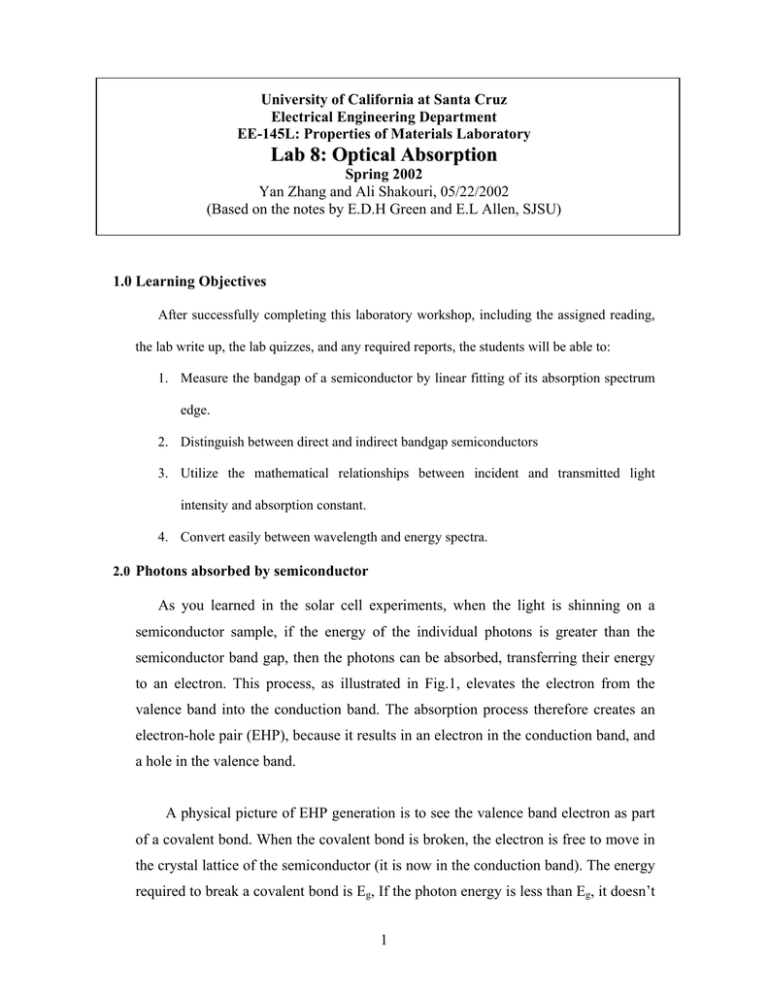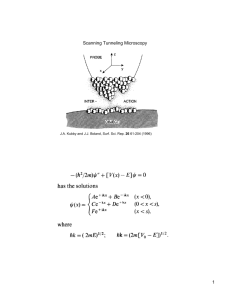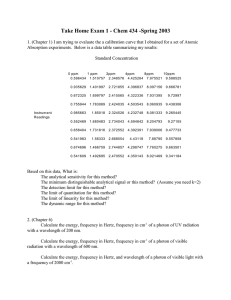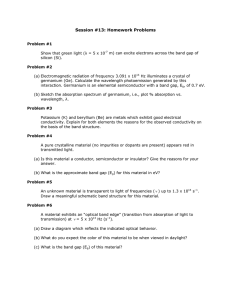Optical Absorption
advertisement

University of California at Santa Cruz Electrical Engineering Department EE-145L: Properties of Materials Laboratory Lab 8: Optical Absorption Spring 2002 Yan Zhang and Ali Shakouri, 05/22/2002 (Based on the notes by E.D.H Green and E.L Allen, SJSU) 1.0 Learning Objectives After successfully completing this laboratory workshop, including the assigned reading, the lab write up, the lab quizzes, and any required reports, the students will be able to: 1. Measure the bandgap of a semiconductor by linear fitting of its absorption spectrum edge. 2. Distinguish between direct and indirect bandgap semiconductors 3. Utilize the mathematical relationships between incident and transmitted light intensity and absorption constant. 4. Convert easily between wavelength and energy spectra. 2.0 Photons absorbed by semiconductor As you learned in the solar cell experiments, when the light is shinning on a semiconductor sample, if the energy of the individual photons is greater than the semiconductor band gap, then the photons can be absorbed, transferring their energy to an electron. This process, as illustrated in Fig.1, elevates the electron from the valence band into the conduction band. The absorption process therefore creates an electron-hole pair (EHP), because it results in an electron in the conduction band, and a hole in the valence band. A physical picture of EHP generation is to see the valence band electron as part of a covalent bond. When the covalent bond is broken, the electron is free to move in the crystal lattice of the semiconductor (it is now in the conduction band). The energy required to break a covalent bond is Eg, If the photon energy is less than Eg, it doesn’t 1 carry enough energy to break a covalent bond and free an electron for conduction. Since electrons cannot occupy the forbidden states between the valence and conduction bands, a photon with energy less than Eg cannot be absorbed and will pass through the sample. In other words, an electron must either be in a covalent bond or free, not in between. In order to study the bandgap of a semiconductor, we can use light with variable photon energy near the band gap energy. We can then observe that light with lower energy photons (long wavelength) is not absorbed and light with higher energy photons (short wavelength) is absorbed. The photon energy at which the transition between absorbing and non-absorbing behavior takes place will correspond to the band gap energy. Because the transition between absorption and transmission is gradual, we will see that the shape of the transition will provide insight into some of the details of the electron interband transitions (this is a transition between energy states in valence band and conduction band). The transition region is called the ‘absorption edge’. Referring to Figure 1, one can see the reason for gradual nature of the absorption edge. Consider the number of electrons available to make a transition from valence band conduction band when Ep=Eg. Only those electrons exactly at Ev can make the transition. As Ep increases above Eg, more and more electrons from the valence band can possibly make the transition, so the overall probability of a photon being absorbed increases. Thus the number of photons absorbed increases. Fig.1 Optical absorption in a semiconductor 2 3.0 Optical absorption, reflection, transmission and scattering In this experiment, we will be shining light of various wavelengths on a silicon sample as well as a GaAs sample. The transmitted light is then measured by a photodetector. By observing the wavelength at which the sample begins to absorb the light, we will determine the bandgap of the sample. In order to accurately measure the absorption, we must account for all of the light incident, reflected, transmitted or scattered by the sample, sample holder and other apparatus. Figure 2 provides definition for the various terms describing the status of light in the experiment. Fig. 2 Shinning light status on a sample The light enters the sample at x=0 is I(0)=I0 (1-R) (eqn.2) I0 is the total incident light intensity and R is the fraction of light reflected at the front surface. For unpolarized light at normal incidence (perpendicular) to a flat surface, the fraction of light reflected is given by: R=(n-1)2/(n+1)2 (eqn. 3) Where n is the index of refraction of the material. For silicon with n=3.874 at wavelengths near 1µm, R=0.348, for GaAs, n=3.59, for GaP, n=3.3 for this range of wavelengths. 3 The light intensity, which is a measure of the flux of photons in the optical beam, decreases through the sample as the photons are absorbed. Because there is a uniform probability of absorption throughout the sample, the intensity reaching any distance x into the sample is I(x)=I0 e-αx (eqn. 4) Where α is the optical absorption coefficient, which is a strong function of wavelength. Large values of α indicate strong absorption, and small values of α indicate weak absorption (negative values of α would imply amplification, but that shouldn’t happen in this experiment.) Finally, taking into account the reflections from both the front and the back surfaces of the wafer, we can write the expression for the amount of light It, which is transmitted through the sample as It=I0 (1-R)2 e-αL (eqn. 5) Where L is the sample thickness. Eqn. 5 ignores the small amount of light that will be reflected multiple times within the sample, but this is a small effect, particularly when α is large. Using Eqn.5, we see that we can determine α by measuring transmitted light intensity if we know the incident light intensity light I0, the sample thickness L, and the sample index of refraction n, which determines R. It will also be convenient to define a transmissivity (T) as T (λ ) = It (λ ) I0 (λ ) (eqn. 6) Ideally we could have the maximum transmission through the sample at long wavelengths where there is no absorption Ttheoretical, max=(1-R)2 (eqn. 7) Several effects will reduce our measurement of transmission from the maximum value (Tmax). One effect, the wavelength dependent absorption of light by the sample, is the quantity we are trying to measure. Unfortunately, there will also be light scattering loss due to roughness, dust, etc. We start with the raw 4 measurements of effective transmission (Traw(λ)) which is the ratio of light power measured through the sample to light power without the sample: Traw (λ ) = P ( λ ) through _ sample P ( λ ) without _ sample (eqn.8) By measuring the light power in identical systems with and without the sample, all losses which are not dependent on the sample are equal in both measurements, and therefore do not affect the ratio. Traw(λ) includes measurement of reflection loss and scattering loss in addition to absorption loss. Reflection loss is not strongly dependent on wavelength. If we assume that scattering strongly wavelength dependent either, only the absorption should change as the wavelength is varied. At a wavelength with no absorption, we will measure the maximum value of Traw, max, from which we can define a normalizing parameter S= Traw , max Ttheoretical , max (eqn. 9) where Traw,max is the maximum measured transmission value and Ttheoretical, max is the theoretically expected maximum transmission (Eqn.7). From the assumption that scattering is wavelength independent, we can now normalize all of the measured data so that the effects of scattering are removed. Tnormalized (λ ) = Traw ( λ ) S = e − aL (eqn.10) While the assumption that S is wavelength independent is not entirely justified, the data should be greatly improved by applying Eqn. 10 to the raw measured transmission Traw (λ) to create the normalized data Tnormalized (λ). 4.0 Wavelength dependence of α It is indicated above that α, the optical absorption coefficient of a semiconductor, will depend on wavelength because of the relationship between absorption and the semiconductor band gap. 1. Direct Bandgap Direct bandgap semiconductor (such as GaAs obey the relation) 5 α = K d ( E p − E g )1 / 2 (eqn. 11) There is only one proportional constant, because direct bandgap materials do not involve phonons (lattice vibrations) in electron band-to-band transitions. 2. Indirect Bandgap For direct bandgap semiconductors (such as silicon and germanium), α takes on the general form of α = K i ,a [ E p − ( E g − E phonon )]2 + K i ,e [ E p − ( E g + E phonon )]2 if Ep>Eg+Ephonon α = K i ,a [ E p − ( E g − E phonon )]2 if Eg-Ephonon<Ep<Eg+Ephonon α=0 if Ep<Eg-Ephonon Ki,a and Ki,e are proportionality constants which depend on the units chosen for α and E. The constant Ki is representative of the probability of phonon absorption or emission, which must accompany the photon absorption in order to alter the valence band electron’s momentum as well as energy. The term phonon refers to a unit of lattice vibration. Phonon absorption requires the semiconductor to obtain energy (heat) from its surroundings simultaneously with the electron transition. Because energy is simultaneously coming from two sources, the photon and the phonon, the band-to-band transition can actually occur even though Ep<Eg. As the photon energy is increased, an alternative mechanism of momentum change becomes possible. In phonon emission, the semiconductor lattice gives up a unit of vibration to its surroundings simultaneously with the photon absorption. It’s much more probable to emit a phonon than absorb one, so we will see Ki,a<Ki,e. Because direct and indirect bandgap semiconductors have different exponents in the α versus Ep relationship, it should be possible to determine the nature of a semiconductor’s band-to-band transition by observing how α is changing with Ep. Energy and wavelength of the photon are related by the relation Ep=hν=hc/λ. c is the light velocity in the vacuum, h the Planck constant, and λ the light wavelength. It can be shown that: E p (in eV ) = 1.24 λ (in microns) 6 5.0 Power and Intensity There is a frequent confusion between the meanings of the words “power” and “intensity”. Power has units of watts (w); it is the amount of energy in an optical beam per unit time. If N photons each with energy Ep reached a target in ∆t seconds, the power reaching the target would be P= N ×E p ∆t (eqn.12) if Ep is measured in joules (J), P will be in watts. The conversion between joules and eV is 1eV=1.60x10-19 J. Intensity (I) refers to the amount of power per unit area in a beam of light. It is often convenient to speak of intensity because it does not require us to know the size of the illumination. 6.0 Photodiode A photodiode is a semiconductor p-n junction diode, which is packaged behind a window. When light shines on the photodiode, its normally negligible reverse bias leakage current is increased. The new reverse bias current in the diode is proportional to the amount of power striking the diode. This fact can be rewritten as I photo = R ⋅ P (eqn.13) where Iphoto is the amount of reverse bias current generated in the diode, and R is the “responsivity” of the diode, how many amperes it generates for a given power of incident light. In order to convert the current generated by the photodiode into a readable voltage, a trnasimpedence amplifier can be employed. A simple transimpedance configuration is shown in Figure 4. 7 Fig. 4 Photodiode and transimpedance amplifier 7.0 Apparatus • Silicon sample, GaAs sample • Monochromator • Tungsten lamp source • Lock-in amplifier • Light chopper • Si photodiode 8.0 Experimental Set-up The figure 5 shows the experimental set-up of the optical absorption experiments. The setup mainly includes the Tungsten lamp, which the light source, monochromator, light chopper and lock in amplifiers. The detailed function of each equipment and the experimental procedures, please follow the instructors in the lab. Figure 5. Experimental set-up 8 9.0 Calculations 9.1 Calculate the photon energy (in eV) for certain wavelength of light 9.2 Understand the photon absorption spectrum 9.3 Understand the transmission spectrum 9.4 Calculate Ttheoretical, max , S, bandgap energy, and absorption coefficient α for each sample 9.5 Plot the graph of transmission vs. photon energy to distinguish the direct bandgap and indirect bandgap samples. For a direct bandgap sample, we expect α to depend on Ep1/2, for indirect bandgap, we expect α to depend on Ep2. Thus the relation of Ep and α could be used to determine the direct and indirect bandgap materials. 10.0 Report The report should show full understanding of the theoretical background, operation procedures and result data of the experiments. The lab report should include the following several parts: o Abstract o Theoretical background o Materials and equipments o Lab set-up layout o Experimental data o Data calculation and analysis o Conclusion 11.0 Refrences: 1.Chapters 5.7 of S.O Kasap. Electrical Engineering Materials and Devices. Irwin 1997 2. http://www.ElectronicMaterials.Usask.ca 3. Chapter 4.1 of B.Streetman,Solid-State Electronic Devices, 4th Edition., Prentice-Hall, 1995, This is your EE 128 textbook. 9


